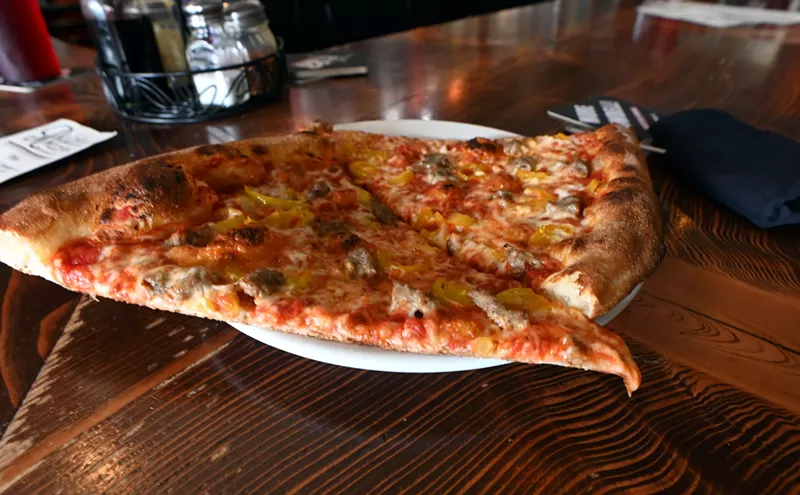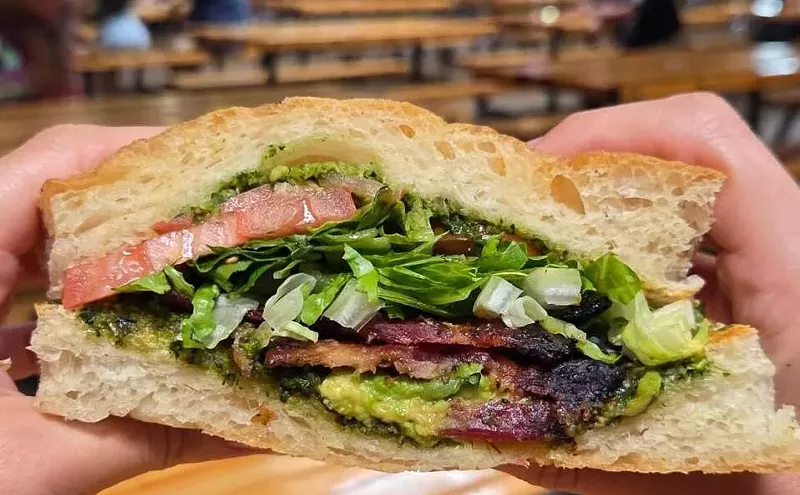In ancient Tokyo, then known as Edo, fishmongers were the street-corner hot-dog vendors, the midnight tamale sellers of their day. That their medium was fish, vinegar and rice balls rather than wieners and kraut or chicken and masa didn't make a lick of difference in the great scheme of things. What set these primitive sushi rollers apart from their modern fast-food counterparts, however, is something in the Japanese character that calls for -- commands, even -- a constant, never-ending process of winnowing and re-evaluation of anything the culture considers art. And edomae sushi certainly qualifies. The cuisine has been refined and focused and sharpened like a knife over countless generations until the leading edge of its mastery can be expressed in nothing more than a hundred grains of rice, a slip of nori seaweed and a single slice of yellowtail hamachi -- one perfect bite hundreds of years in the making. Simplicity, quiet, clear and clean boundaries, restraint, a balancing of the senses -- these are all of the utmost importance. So is a nod to the passing seasons -- not necessarily in taste, but in texture, temperature and presentation. The ultimate goal of all this sifting and examination is to determine precisely what's necessary in the enjoyment of a thing, then do away with whatever isn't absolutely essential to the experience.
There's something oh-so-Zen about sushi, something meditative and centering and pure. Even bad sushi -- like the stuff you get out of the deli case in the grocery store -- has this calming quality. Each piece is self-contained, is meant to be eaten in a single bite, and requires nothing -- no sauce, no garnish -- to improve it. Each piece strives for perfection. If it doesn't get there (and few pieces do), there's still something noble in the attempt. Sushi is a food that lays everything out, that cannot hide or disguise its weaknesses, and that's admirable. As practiced in the strip malls of our modern republic, though, sushi is changing, as the ideology (almost theology) of the Japanese sushi culture -- where a single ounce of fatty tuna belly sells for more than the same weight in pure coke and almost as much as gold -- meets the quick-and-dirty, everything-for-a-buck, cheap but vital mentality of the hot-dog man. And Kassai Sushi is at the crossroads.
As I sit at Kassai Sushi's comfortably appointed sushi bar, lost in quiet contemplation of a white plate lined with six pieces of tekka maki (that most basic of rolls in the classical canon), a pink twist of pickled ginger and a mound of fierce wasabe paste, I can tell that I'm creeping out the staff. The sushi chef toiling behind the bar keeps one eye on the dragon roll he's shaping, the other on me. The one waitress working the right-hand dining room of this smallish, suburban strip-mall space gives me a look as she drifts past, slapping sushi orders down on the bar, talking to the chef in rapid-fire Japanese that, to me, has always sounded like the quick squawking of highly educated birds. To someone looking in from outside, I must appear like one of those Hollywood FX shots -- the kind where the camera focuses on one guy moving at normal speed while everyone and everything around him is sped up into a fast-forward blur of motion, usually used to signify disappointment and alienation. To the staff, I must look like I've found something wrong on my plate. But I'm not alienated, and there's nothing wrong. There are few places in the world where I feel more comfortable than at a sushi bar. I'm simply settling in. My standard metabolism is tuned way too high for Japanese food. I am a twitchy, jittery, spastic man with unusual tastes, but I find solace in sushi. It sometimes just takes me a few minutes, a cup of tea, maybe some deep breathing, to get there.
I raise my heavy gray ceramic mug and take a sip of hot green tea. Almost before I can set the mug down, the waitress is at my elbow, topping it off.
"Everything okay?" she asks, lingering, honestly concerned.
"Absolutely," I say, giving her my best smile. "I'm just waiting."
"Someone joining you?"
"Nope." I turn back to my tea, inhale the vapors. "Just waiting."
She leaves. I pour a little puddle of soy into the dish on the bar, break apart my chopsticks, pick up the first slice of tekka maki and pop it in my mouth.
Always order tekka first. That's my rule. Green tea, miso soup if the weather is cold, tekka maki. The tuna rolls -- black nori wrapped around white rice with a core of lean, raw tuna loin -- are the simplest, most approachable item on any traditional sushi menu. They are a benchmark for the chef, a barometer by which to measure his skill and the quality of his ingredients. This roll is studded with white sesame seeds, a different twist. The rice is done well -- stiff and sticky, not smooshy, certainly not crunchy (if this were pasta, it would be a perfect al dente). And the tuna itself is shiny purple, smooth, fresh and delicate, more texture than flavor, which is as it should be. If you can taste the tuna, it's old. And old tuna does not taste good, so you'll know it when you run across it.
Around me, an early dinner crowd has the place better than half full; tables of two, three, four people are bolting down maki and nigiri rolls like Chicken McNuggets, wolfing sashimi like they have movie tickets and don't want to miss the previews. This makes me happy: Sushi has become so ubiquitous on the American culinary scene that it's often treated like fast food (which is exactly what edomae sushi was, originally). On all sides there are neighborhood folk -- young couples, soccer moms, career types chattering on their cell phones -- snapping away with their chopsticks and fingers, eating tempura, nibbling chirashi (a sashimi sampler, the raw fish laid like rainbow stripes across a box of sticky sushi rice), devouring salmon-skin rolls and slurping udon like it was nothing. Sushi today, Whoppers tomorrow, tamales or gyros the day after.
The decor at Kassai Sushi, which occupies the former home of Thai Basil II, is harmless Amerasian strip-mall chic, all lacquered wood and chrome. The floor staff is friendly. The chefs and cooks work quickly and cleanly. I sip my tea, finish my tekka maki and put in a more substantive order at the bar: ebi su (butterflied shrimp soaked in a brutally stinging rice vinegar and ginger sauce), tako (thick slabs of some of the freshest octopus I've ever seen outside the real high-end sushi bars, with a texture like chewing cold pencil erasers), a round of futo (egg and julienned cucumber with sweet crab meat, avocado and bitter little Japanese oshinko pickles).
I like this place. I like it a lot. The owners seem to understand on a very basic level the way American eating habits are changing, and they're taking advantage of all of them. For starters, they deliver -- anything on the menu, any time the woks are hot. They balance maki, nigiri and sashimi classics with Japanese street food like gyoza, fat little shumai dumplings filled with ground shrimp, inari fish-cake soup, golden-fried strips of tonkatsu and crispy-hot soft-shell crab, sweet and juicy inside its panko crust. They offer combo meals -- chirashi, variety platters from the fish bar and bento boxes served with soups and salads -- and keep long hours, seven days a week, with a six-hour happy hour every day, from 4 to 10 p.m., featuring a spread of buck-a-roll selections.
With all this, Kassai Sushi represents an evolutionary step in the modern American raw-fish trade: fast-casual sushi, doing for tamago, unagi and yakitori what Chipotle did for carnitas burritos and corn salsa. Making such things accessible, inexpensive and downright common, allowing anyone at all to fill his face with something that, maybe five years ago, he wouldn't even have been able to put a name to.
The sushi line even does a commendable job with those cross-border translations, those blasphemies against the pure simplicity of authentic sushi: American rolls. Under normal circumstances, I would consider the spider roll -- an inside-out roll of sushi rice sprinkled with neon-orange fish roe wrapped around deep-fried soft-shell crab legs, slices of avocado and lettuce -- an abomination. It's not sushi. It's not even in the same family, except that it's round and involves rice.
But Kassai Sushi's spider roll is just fine for what it is: soft rice and crunchy, salty crab, the yielding smoothness of fresh avocado and the crisp snap of cool lettuce. These disparate elements are assembled with a care often missing when sushi chefs start catering to the American taste for extreme and overwhelming flavors with all the subtlety of sledgehammer blows.
On subsequent visits, I balance rounds of ama ebi (raw shrimp, sweet and almost tinny in flavor) against the smoked salmon and cream cheese Philadelphia roll (yuck). I make a last foray into the modern world with an order of the archetypal California rolls, sucking down big pieces of inside-out rice and nori gunked up with cream cheese, avocado, cucumber and bright-red crab that together are precisely as horrible as they sound. California has been responsible for a lot of culinary sins, including vegetarianism, the raw-food movement and Spanish-fusion tapas. But the California roll may be the most grievous sin -- the one against good taste, for which there can be no forgiveness.
Late on a Saturday, I put the sushi bar to a final test, ordering a round of yellowtail hand-rolls 45 minutes before closing, just to see if the fish had been allowed to go dank at the end of a busy day of service. But Kassai Sushi turns out to be as good at closing time as it is when the sushi bar opens for business -- and that's good for the chef, good for the customers and especially good for me, because I live not far away.
The ancient sushi master and the modern hot-dog man have a lot in common. They have similar callings; their roots are in the same place; and they've reached a sort of cultural détente in the strip-mall quick-service game. But ten decades from now, diners probably won't be sitting around some table venerating the humble, twentieth-century hot-dog man the way we do the Edo sushi rollers of old. The reason is the level of obsession brought to each cuisine. Sushi has become an art, and art survives despite any uglifying influence of commerce. But a hot dog -- even a great one -- is still just a hot dog.












